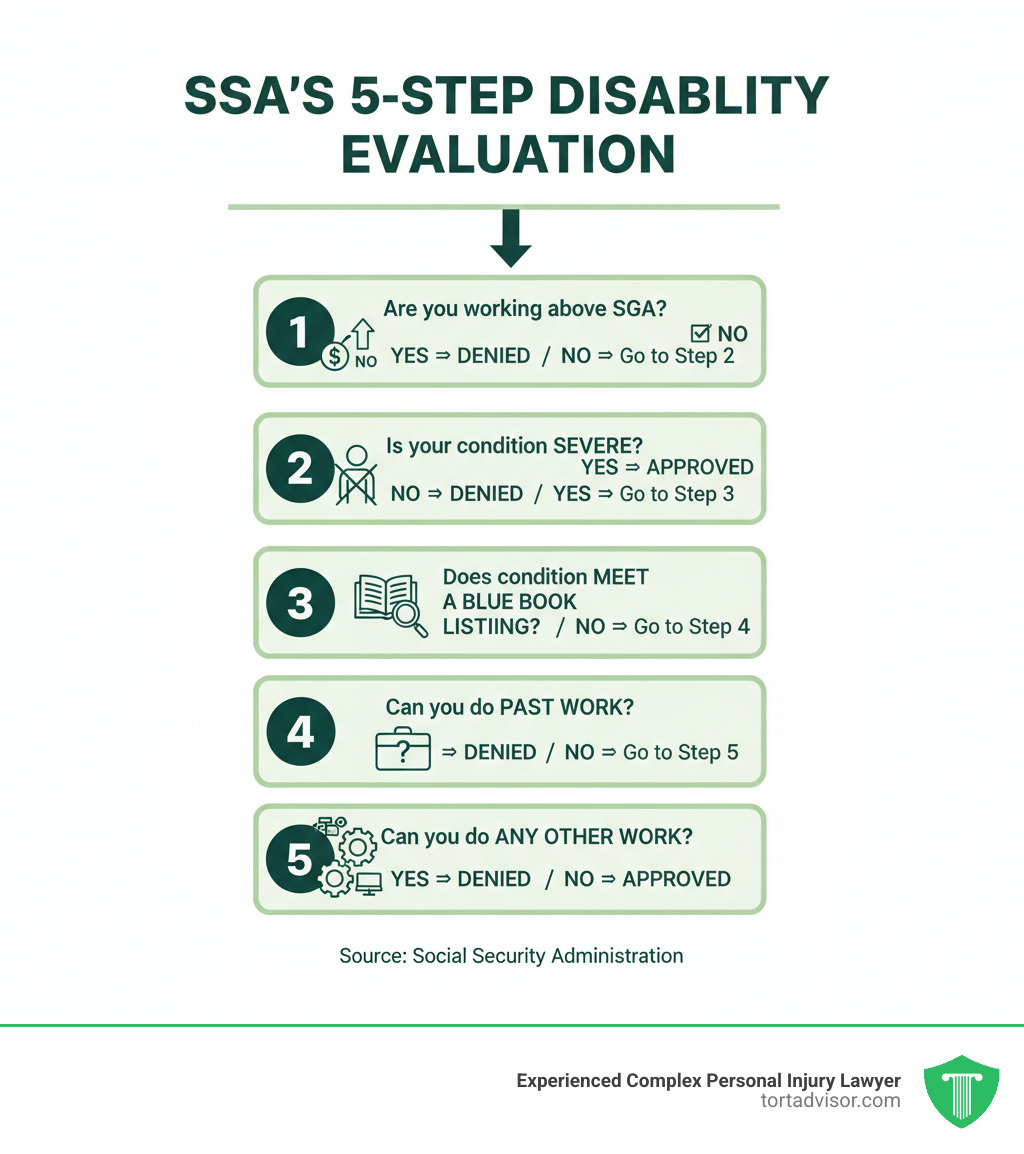

Why Your SSDI Application Strategy Matters More Than You Think
The right SSDI application tips can mean the difference between approval and denial. The Social Security Administration (SSA) initially denies about 70% of SSDI applications, often due to correctable errors in a complex process, not because the applicant isn’t disabled.
Essential SSDI application tips to improve your chances:
- Understand the SSA’s definition of disability: Your condition must prevent substantial work and last 12+ months.
- Gather complete medical evidence: Include all doctor’s notes, test results, and treatment records.
- Document your daily life: Keep a journal tracking struggles, pain, and symptoms.
- Meet work credit requirements: Ensure you have a sufficient work history.
- Be truthful and consistent: Inconsistencies can lead to denial.
- Avoid common errors: Complete all forms accurately and meet every deadline.
- Involve your doctors: Their opinions and RFC assessments are critical.
- Consider professional help: Applicants with attorneys are three times more likely to win.
The SSDI application process is intimidating, with strict criteria and extensive paperwork that can trip up deserving applicants. The average case can take over two years from start to finish.
This guide is your roadmap for preparing a strong SSDI application. You’ll learn what the SSA looks for, which documents matter most, and how to avoid common pitfalls. These proven strategies will help you present the strongest possible case, whether you’re filing for the first time or appealing a denial.
Know your SSDI application tips terms:
- Denied disability claim
- Disability claim assistance
Understanding the Battlefield: SSDI vs. SSI and Eligibility Rules
Before using SSDI application tips, you must understand the rules. The Social Security Administration’s definition of “disability” is specific and strict, and knowing it can save you months of frustration.
The SSA’s Strict Definition of Disability
To qualify as disabled under SSA rules, you must meet three criteria. First, you need a medically determinable physical or mental impairment backed by objective evidence like lab results or scans. Your word alone is not enough.
Second, your condition must have lasted or be expected to last for at least 12 continuous months, or result in death. If your doctor expects a recovery within a year, you won’t qualify.
Third, your impairment must prevent you from performing Substantial Gainful Activity (SGA), meaning you cannot do substantial work that earns above a certain income. This narrow definition, evaluated through a 5-step process, is why many initial applications are denied.
SSDI vs. SSI: What’s the Difference?
Social Security disability benefits consist of two different programs: Social Security Disability Insurance (SSDI) and Supplemental Security Income (SSI).
SSDI is an insurance program you’ve paid into via payroll taxes. To qualify, you need enough work credits from paying Social Security taxes. Your benefit amount is based on your lifetime average earnings.
SSI is a needs-based program for disabled individuals with limited income and resources, regardless of work history. There are strict financial limits; an individual cannot have more than $2,000 in countable resources ($3,000 for a couple).
| Feature | SSDI (Social Security Disability Insurance) | SSI (Supplemental Security Income) |
|---|---|---|
| Nature of Program | Insurance program for workers and their families | Needs-based program for individuals with limited income and resources |
| Eligibility | Based on work history and payment of FICA taxes (work credits) | Based on financial need (low income and limited assets) |
| Work Credits | Required; typically 40 credits, with 20 earned in the last 10 years | Not required; no work history needed |
| Benefit Amount | Varies based on lifetime average earnings | Flat federal amount, potentially supplemented by states |
| Medical Criteria | Must meet SSA’s definition of disability | Must meet SSA’s definition of disability |
| Spouse/Children | May receive benefits based on your record | Generally no additional benefits for family members |
You can sometimes qualify for both programs. You can find more info about SSDI and SSI differences to determine which program applies to you.
Non-Medical Requirements: Work Credits and SGA
Even with a qualifying medical condition, you must clear non-medical problems.
Work credits are the basis of SSDI. You earn them by working and paying Social Security taxes. In 2024, you get one credit for each $1,730 earned, up to four per year. Most people need 40 credits total, with 20 earned in the last 10 years before disability. Younger workers may qualify with fewer credits.
Substantial Gainful Activity (SGA) is crucial. If the SSA finds you’re performing SGA, your claim will be denied before your medical records are even reviewed. For 2024, if you earn more than $1,550 per month ($2,590 for blind individuals), the SSA generally considers you engaged in SGA. Check the current SGA income thresholds as they change annually. Working part-time while applying requires careful monitoring of your earnings to stay below this limit.
Special Considerations: Age, Education, and Compassionate Allowances
The SSA applies “Grid Rules” for applicants over age 50, recognizing it’s harder to retrain for new work. These rules consider your age, education, and past work experience. An older worker with a history of physical labor has a better chance of qualifying than a younger applicant with a college degree, even with similar medical issues.
The Compassionate Allowances (CAL) program fast-tracks applications for severe conditions like aggressive cancers, ALS, or early-onset Alzheimer’s. If your condition is on the CAL list, your claim can be approved in weeks instead of months. Check the list of Compassionate Allowances conditions and clearly note it on your application if you qualify.
Assembling Your Arsenal: Crucial Documentation and Medical Evidence
A strong case is built on solid evidence. Thorough preparation is one of the most powerful SSDI application tips.
The Power of Comprehensive Medical Records
Your medical records are the foundation of your claim. The SSA relies on objective medical evidence to verify your condition’s severity. Your case is only as strong as your documentation.
You must gather everything related to your condition, including:
- Doctor’s notes and reports detailing diagnoses, symptoms, treatments, and functional limitations.
- Lab results and imaging reports (X-rays, MRIs, CT scans).
- Hospitalization records, including ER visits and discharge summaries.
- Physical and occupational therapy notes.
- A complete medication list with dosages and side effects.
- Surgical reports.
It’s your responsibility to provide the SSA with accurate contact information for all your providers. Missing records can cause significant delays.
Your Doctor’s Role and Following Treatment
Your treating physicians are your best allies. Keep them informed about your disability application and discuss how your condition limits your ability to work. Opinions from specialists can significantly strengthen your claim, especially for conditions like fibromyalgia or chronic fatigue.
A critical SSDI application tip: you must maintain regular medical treatment and follow your doctor’s orders. Gaps in treatment can suggest your condition isn’t severe. If you lack insurance, apply for Medicaid to ensure consistent care.
Ask your doctor to complete a Residual Functional Capacity (RFC) assessment. This form details your ability to perform work-related tasks (sit, stand, lift, etc.) and is one of the most critical pieces of evidence you can submit.
Essential SSDI Application Tips for Documenting Your Condition
Your personal insights are vital for showing how your disability affects your daily life.
Keep a disability journal. Document your daily struggles, pain levels, symptom frequency, and medication side effects. Be specific. Instead of “I have back pain,” write, “My back pain was 8/10 today, forcing me to lie down for three hours after standing for 10 minutes.” This detail helps the SSA understand the true impact of your condition.
When describing your disability on forms, focus on how symptoms limit specific activities. Use concrete examples.
Review the SSA’s Blue Book, which lists impairments that automatically qualify for disability. Understanding if your condition meets or equals a listing helps you structure your application effectively.
Preparing Your Information with the SSA Starter Kit
The SSA’s Adult Disability Starter Kit is an excellent resource. Before you begin, create a ‘my Social Security’ account to check your earnings record and track your application status.
Gather the following information beforehand:
- Personal details: Birth date, Social Security number, citizenship status.
- Family information: Marriage/divorce dates, spouse and children’s information.
- Work history: A list of jobs from the past 15 years with duties, dates, and pay.
- Medical provider contacts: Names, addresses, and phone numbers for all doctors, hospitals, and clinics.
- Medical tests and medications: A complete list of tests and all medications.
You can download the Adult Disability Starter Kit from the SSA website. Gathering this information first will make the application process much smoother.
The Application Gauntlet: Forms, Honesty, and Key SSDI Application Tips
You’ve prepared your documents; now it’s time to tackle the application itself. Precision here is key.
Filling Out the Forms: The Function and Work History Reports
Two key forms are the Function Report (SSA-3373-BK) and the Work History Report (SSA-3369-BK).
The Function Report is your chance to describe your daily reality. Be specific. Instead of writing “I can’t clean,” explain why: “I can only stand for 10 minutes before my back pain becomes unbearable, making it impossible to vacuum.”
The Work History Report documents your jobs over the last 15 years. The SSA uses this to see if you can do your past work. Be thorough in describing the physical and mental demands. If you were a retail manager, detail the standing, lifting (e.g., 40-pound boxes), and stress involved, then explain why you can no longer perform those tasks.
The golden rule: detailed answers are better than short ones. Use “N/A” for questions that don’t apply instead of leaving them blank.
More Advanced SSDI Application Tips: The ‘Why’ Behind the Questions
Truthfulness and consistency are paramount. Do not exaggerate. Inconsistencies between your application, medical records, and interviews can destroy your credibility. Be honest about your good and bad days. For example: “My pain ranges from 5/10 to 8/10. I experience 8/10 pain about four days a week, which makes productive activity impossible.”
The SSA focuses on relevant information: medical evidence and functional limitations. They generally do not consider personal financial need, lack of transportation, or the local job market. Stick to the facts about your inability to work.
During your SSA interview, be prepared. Have your documents organized and answer questions directly and consistently with your written application.
Avoiding Common Application Errors
Many of the 70% of initial denials are due to preventable mistakes. Avoid these common errors:
- Incomplete forms: Answer every question, even if it’s with “none” or “not applicable.”
- Missing deadlines: You have exactly 60 days to appeal a denial. Missing this deadline means starting over.
- Insufficient medical evidence: Provide detailed records and explain any gaps in treatment.
- Inconsistent information: Ensure your statements match across all forms and align with your medical records.
- Exceeding the SGA threshold: Earning too much while your application is pending can lead to an automatic denial. Track your income carefully.
- Not listing all conditions: The SSA considers the combined effect of all your impairments. List everything that limits you.
- Losing your re-entry number: If applying online, save the re-entry number that lets you return to your application.
- Failing to cooperate: Always attend scheduled exams (like a Consultative Examination) and respond promptly to SSA requests.
Navigating the Process and When to Call for Backup
After submitting your application, the waiting game begins. Understanding the next steps can help manage expectations.
The SSDI Timeline: From Application to Decision
The SSDI process is not quick. An initial decision typically takes three to five months. If appeals are necessary, the entire process can take more than two years.
Your application goes to a state agency called Disability Determination Services (DDS) for medical review. DDS experts will review your records and may contact your doctors.
DDS might schedule you for a Consultative Examination (CE) with one of their doctors if they need more information. You must attend this appointment. Be honest about your limitations during the exam. The long wait is normal, so it’s important to set realistic expectations.
The Appeals Process for a Denied Disability Claim
About 70% of initial SSDI applications are denied. This is often not the final word, as many applicants win their cases on appeal.
If you receive a denial, you have exactly 60 days to file an appeal. Missing this deadline usually means starting the entire process over. The appeals process has four levels:
- Reconsideration: A new reviewer at DDS examines your case. Denials at this stage are also common.
- Hearing before an Administrative Law Judge (ALJ): This is often your best chance for approval. You can present your case in person and have an attorney advocate for you. Wait times for a hearing can be a year or longer.
- Appeals Council: If the ALJ denies your claim, you can ask the Appeals Council to review the decision.
- Federal District Court: This is the final step, involving a lawsuit.
The 60-day deadline applies at each stage. Understanding what to do after a denied disability claim is crucial.
The Benefits of Hiring a Disability Attorney
Given the complexity and high denial rates, consider hiring an experienced disability attorney. Applicants with attorneys are three times more likely to win their cases.
Disability attorneys work on a contingency fee basis, meaning they only get paid if you win. By law, their fee is capped at 25% of your back pay, up to a maximum amount set by the SSA. If you don’t win, you owe no attorney fees.
An attorney is especially valuable at the ALJ hearing. They know what evidence judges value, how to present your case, and how to handle all the administrative work. This lets you focus on your health. At Tort Advisor, we provide Disability Claim Assistance by connecting clients with top-rated attorneys who have proven track records in disability law.
Additional Resources and Special Situations
The SSA offers resources for special circumstances. Vocational Rehabilitation (VR) services can help you explore returning to work; an unsuccessful attempt can strengthen your claim. The SSA also provides free interpreter services and has special procedures for individuals experiencing homelessness. Your personal information is protected by the Privacy Act of 1974.
Frequently Asked Questions about the SSDI Application
Here are answers to some of the most common questions about the SSDI process.
What is the fastest way to get approved for disability?
While there’s no magic button, you can speed up the process. The fastest path is having a condition that meets a Blue Book listing or qualifies for the Compassionate Allowances (CAL) program for severe illnesses.
For everyone else, the most practical SSDI application tip for a faster decision is to submit a complete, well-documented application from the start. When the SSA has all the necessary medical records and information upfront, it reduces delays caused by requests for more information.
Can I apply for SSDI if I am still working part-time?
Yes, you can apply while working part-time, but there’s a critical rule: your earnings cannot exceed the Substantial Gainful Activity (SGA) threshold. For 2023, this was $1,470 per month for most people ($2,460 for blind individuals). These amounts change annually, so always check the current SGA income thresholds.
If you earn above the SGA limit, the SSA will likely deny your claim. If you earn below it, the SSA will still examine the nature of your work to see if it demonstrates an ability to sustain employment. Be prepared to explain why you have reduced hours or require special accommodations.
How much does it cost to hire a disability lawyer?
This is a common concern, but the good news is that disability lawyers work on a contingency fee basis. This means you pay no attorney fees unless you win your case.
If you win, the fee is limited by federal law to 25% of your past-due benefits (back pay), up to a maximum cap (around $9,200 in recent years, but this can change). For example, if your back pay is $20,000, the attorney’s fee would be $5,000. This “no win, no fee” structure makes expert legal help accessible. Seeking Disability Claim Assistance is a low-risk way to improve your chances, as applicants with attorneys are three times more likely to be approved.
Conclusion: Take Control of Your SSDI Claim
Navigating a disabling condition and the SSA’s bureaucracy is challenging, but approval is possible. The SSDI application tips in this guide are practical strategies to help you secure the benefits you deserve.
Preparation is everything. The difference between approval and denial often lies in how well you document your condition and communicate your limitations. The SSA has specific requirements, and meeting them is your key to success.
The process is a marathon, not a sprint, and can take months or even years. This is where professional guidance provides immense value. Applicants with attorneys are three times more likely to win their cases. An experienced disability lawyer knows what the SSA needs, handles the complex appeals process, and works on contingency, so you only pay if you win.
At Tort Advisor, we connect people with top-rated specialty attorneys who have proven track records in disability law. We believe everyone deserves expert representation when their financial security is at stake.
Don’t let the system discourage you. You’ve taken the first step by educating yourself. Now, take control of your claim and work towards securing the benefits you’ve earned.
Disclaimer: This article provides general information and does not constitute legal advice. The SSDI application process is complex, and individual situations vary. We recommend consulting with a qualified disability attorney for personalized guidance.
Free Confidential Case Evaluation
Complete the short form below to get an immediate FREE case review with an expert in your specific claim. Don't wait, your case could be time sensitive to file a claim.
Related Posts
Did a North Dakota product cause harm? Understand product liability, your rights, and how to take action for defects.
Get justice for clergy abuse. Find an expert Priest abuse lawyer to navigate complex laws and hold institutions accountable.
Diagnosed with meningioma after Depo-Provera? Understand potential Depo-Provera lawsuit settlements, risks, & how to claim compensation.
Uncover the truth about uber sexual assault cases. Learn about the alarming scale, Uber's accountability, and legal options for justice.
Facing wildfire losses? Discover the best wildfire lawsuit attorneys in California to fight for your full recovery and justice.
Exposed to Roundup & diagnosed with NHL? Discover how to sue Monsanto, understand eligibility, & seek compensation. Your guide to justice.











